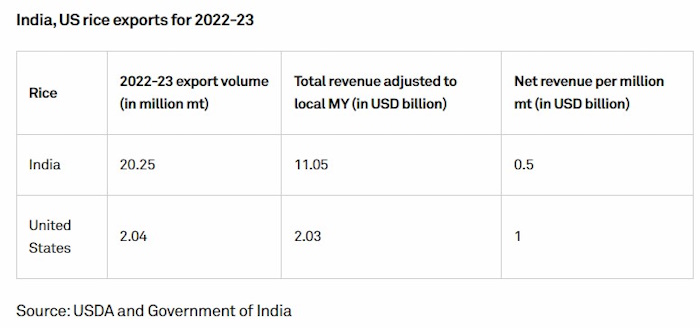China to determine market trend for soybeans and soybean meal: IGC Director

International Grains Council Executive Director Arnaud Petit has said that China will be determining the market trend for soybeans and soybean meal as the biggest demand center.
Speaking at the launch of India Grains and Pulses Council April 12, Petit emphasized on a higher output projection for soybeans in the marketing year 2024-25 amid a strong global demand forecast.
IGC projects world soybean output to reach a record 413 million mt in MY 2024-25, increasing 5.9% from the MY 2023-24 forecast of 390 million mt, according to its latest grain market report.
IGC forecasts global soybeans demand to rise 3.6% year on year in MY 2024-25 to reach 172 million mt.

Oilseed trade between Brazil and China provides an overview of the dominating equation between the world’s largest supplier and the biggest consumer.
China imports its largest volumes of soybeans from Brazil, which overtook the US to become the world’s top exporter of the oilseed in MY 2023-24.
Over April 2023 to April 2024, China’s soybean imports amounted to 99.9 million mt in volume. Out of this, 71.4 million mt was supplied by Brazil, making up for 71.5% of China’s total soybean imports for the period, according to S&P Global Commodities at Sea.

Similarly, in the same period,China imported a total of 926,032 mt of soybean meal, buying roughly 777,000 mt or 84% from Brazil.
The year 2024 began with a strong outlook for world’s total grains, with market sources anticipating an increase in production and trade compared to the previous year, driven by factors such as recovery of crops in Argentina from the drought-induced failure in MY 2022-23.
Argentina, a major supplier of corn, soybeans, and wheat, witnessed a significant drop in its MY 2022-23 production campaigns due to a severe drought.

In Argentina, early corn is usually planted over September-October and harvested in April-May, while the late corn crop is sown in December-January and harvested in June-July.
However, Argentina’s MY 2023-24 campaign started with El Nino favoring its crops and leading output to the road of recovery. This recovery makes a difference to Argentina’s overall produce, and eventually the world’s total output.

“Ample grains are available today because of Argentina and Brazil, therefore grains prices are low,” Petit said.
An evaluation of Platts prices for Argentina corn FOB Up River, Brazil corn FOB Santos, and US corn CIF New Orleans for the last three years suggests that corn prices among the major suppliers are trading at their lowest levels for the period.
Speaking about the challenges to trade, Petit highlighted that any resistance to supply chain and logistics could have a negative impact on ease of trade and prices.
In 2023, decreasing water levels at several basins of the Mississippi River — crucial artillery for the export of grains from the US — added to logistical costs of US corn exports.

Due to the increased transit time and costs, several traders had started shifting to Brazil for their corn supplies, a Mexican trader told S&P Global Commodity Insights.
Similarly, incidents like low levels in the Panama Canal and rising tensions in the Red Sea, impact shipping of grains and other commodities, and often increase the transit time by 10-12 days.
“An increase of 10-12 days to the transit time is a tremendous increase,” Petit said, adding that developments such as the attacks in the Red Sea increase trade finance and negatively impact trade opportunities.
S&P Global Commodity Insights attended the launch event of the India Grains and Pulse Council April 12, taking note of agriculture commodity traders and policy makers expressing on the prospects for the country’s grains and pulses exports, and the need to create a value-chain ecosystem.
Despite being a major exporter of agricultural products such as rice and wheat, Indian traders feel they are “underselling” while the approach should be to have pricing premiums originating out of the Indian market, head of an agri-business company said.
“We need a framework for this, because consumers are ready to pay premiums for value and quality,” a source at the event told S&P Global.
In MY 2022-23, US rice exports totaled 2.04 million mt, while Indian exports of rice amounted to 20.25 million mt in volume for the same period, according to the world agricultural supply and demand estimates report April 11.
For MY 2022-23 adjusted to the local marketing year (October-September), India’s revenue from rice exports totaled $11.05 billion, or roughly $545.5 million for each 1 million mt sold, according to the National Import-Export Record.
For the same year adjusted to the local marketing year (August-July), US earned a total revenue of $2.03 billion from rice exports, roughly equivalent to $1 billion for each 1 million mt sold, according to Foreign Agricultural Service data from the USDA.
Read also
Wheat in Southern Brazil Impacted by Dry Weather and Frosts
Oilseed Industry. Leaders and Strategies in the Times of a Great Change
Black Sea & Danube Region: Oilseed and Vegoil Markets Within Ongoing Transfor...
Serbia. The drought will cause extremely high losses for farmers this year
2023/24 Safrinha Corn in Brazil 91% Harvested
Write to us
Our manager will contact you soon



